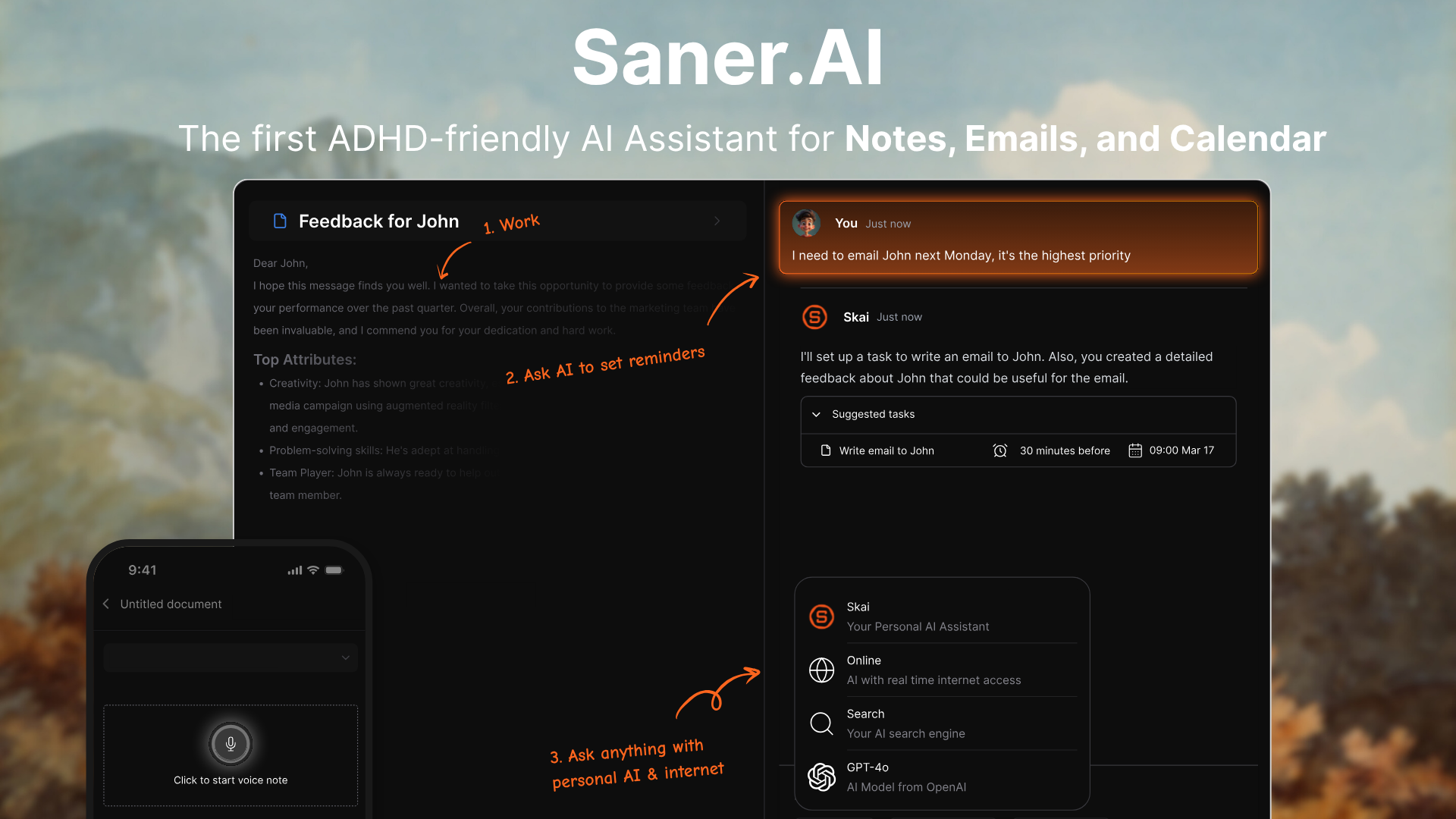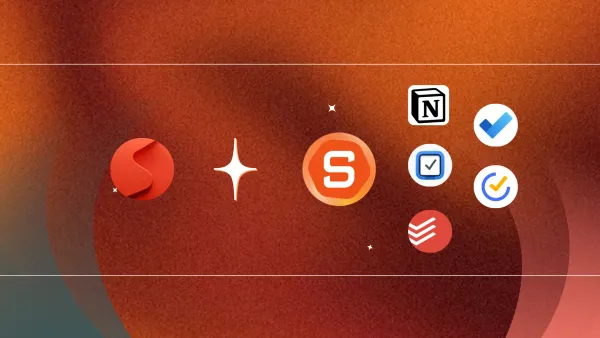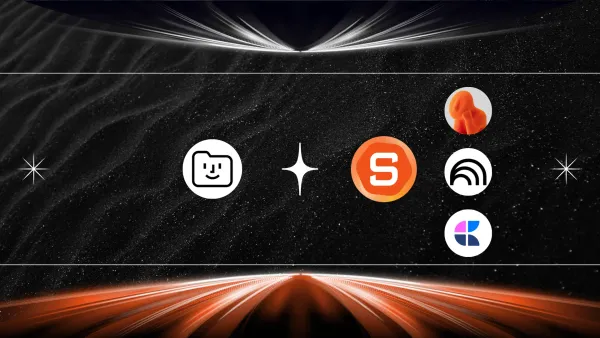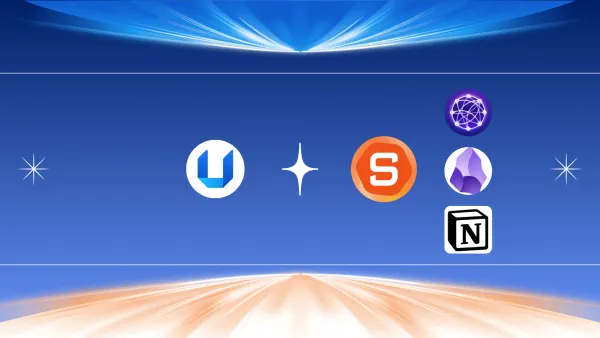Note-Taking Apps: We Tested and Ranked the Best 15 Apps
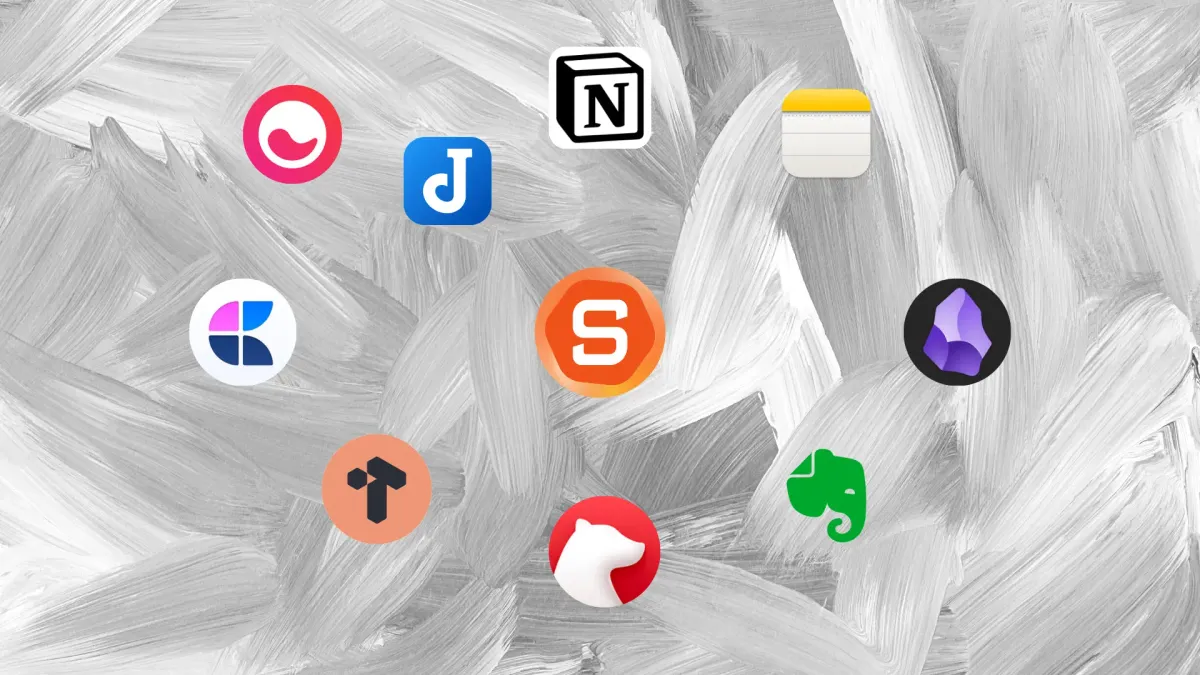
The best 15 Note-Taking Apps in 2025
📌 TL;DR – Best Note-Taking Apps in 2025
- Note-taking in 2025 isn’t just about writing - it’s about thinking smarter. Modern tools use AI to help you organize, recall, and act on your ideas.
- Top AI-powered picks:
- Saner.AI – Best for proactive daily planning, task extraction, and ADHD-friendly workflows.
- Notion – Best all-in-one workspace for docs, databases, and team collaboration.
- Obsidian – Best for researchers and Second Brain lovers who want deep linking and local control.
- Apple Notes – Surprisingly smart in iOS 18 with live transcription and math solving.
- GoodNotes & Craft – Great for handwritten notes or beautiful personal docs.
- AI is the game-changer: Tools like Saner.AI aren’t just note apps - they're smart assistants that reduce mental load.
You jot down ideas during a Zoom call. Scribble a reminder on your phone between errands. Save a voice note while walking your dog. Then when it’s time to find that brilliant insight or important meeting detail… It’s gone. Buried in digital clutter or lost in a forgotten app.
But, you’re not alone.
That’s why note-taking apps are evolving.
In 2025, the best note-taking tools don’t just help you store information.
They help you make sense of it. They turn chaos into clarity. With smarter organization, AI-powered insights, and context-aware reminders, modern apps are built to actually think the way you do.
What makes a great note-taking app today?
Here’s what I looked for when testing tools:
- Fast capture: Can you dump a thought quickly - whether by typing, talking, or dragging?
- Smart organization: Can you easily find and link related ideas or meeting notes?
- Cross-platform: Does it work everywhere, reliably?
- AI power: Does the app just store things - or help you act on them?
- Mental clarity: Does it reduce your cognitive load or just add another inbox?
How I tested each app:
This guide isn’t a feature checklist. I personally tested each tool in real-world scenarios:
- Planning a product launch
- Writing research-heavy content
- Capturing meeting notes and turning them into tasks
- Syncing thoughts across devices and contexts
- Asking AI to help prioritize or recall key decisions
Every tool was evaluated on usability, AI capability, offline access, and how well it fit into actual workflows - not hypothetical ones.
Whether you’re a student managing assignments, a knowledge worker juggling meetings, or a digital minimalist trying to think clearly, this post will help you find a note-taking app that matches how your brain works.
Let’s dive in.
What are the Best Note-Taking Apps?
The Best Note-Taking Apps in 2025 are Saner.AI, Notion, Obsidian, Apple Note and Amplenote
Note-Taking Apps Comparison Table (Updated for 2025)
| App Name | Best For | Platforms | Free / Paid | AI‑Enabled? | Unique Features (2025 updates) |
|---|---|---|---|---|---|
| Saner.AI | AI-first productivity & ADHD-friendly | Web, Mobile | Freemium | ✅ Yes | Notes, email, tasks with personal AI assistant |
| Notion | Team collaboration & docs | Web, macOS, Windows, iOS, Android | Free personal, Paid teams | ✅ Yes (Notion AI) | Block-based editor, templates, databases |
| Obsidian | Local-first Second Brain users | Desktop & Mobile | Free base, Paid sync/plugins | ⚠️ Plugin-based only | Markdown vaults, graph view, huge plugin ecosystem |
| Apple Notes | Quick capture in Apple ecosystem | iOS, macOS | Free | ✅ Yes (iOS 18 AI) | Live audio transcription, math solve, section collapses |
| Evernote | Web clipper & multimedia notes | All major platforms | Free + Paid | ✅ Yes | Web clipping, document scanning, legacy feature-rich |
| Reflect | Backlinked journaling & ideas | Web, iOS (Android beta) | Paid | ✅ Yes | Graph-based daily journaling, calendar sync |
| Tana | Structured outlines & live queries | Web (beta) | Free (beta) | ✅ Yes | Live queries, outline-centric, AI workflows |
| Logseq | Outliner & PKM fans, markdown lovers | Desktop, Mobile, Web | Free, open-source | ⚠️ Plugin-supported | Markdown/org-mode, privacy-first, powerful graph |
| Mem.ai | Smart inbox & automated capture | Web, iOS, Android | Free + Paid | ✅ Yes | AI chat |
| OneNote | Education & Microsoft ecosystem | All platforms | Free (5 GB), Paid for Copilot | ✅ Yes | Stylus support, tabbed notebooks, Microsoft integration |
| Joplin | Privacy-first open-source users | Desktop & Mobile | Free + Paid (Cloud €2.99+) | ❌ No | Markdown, E2EE, open-source, Joplin Cloud sync |
| Amplenote | Task‑centric writing & journaling | Web, iOS, Android, macOS | Free & Paid | ✅ Plugin-based AI | Eisenhower prioritization, mood tracking, calendar tasks |
| Bear | Elegant Apple‑only markdown notes | macOS, iOS, iPadOS | Freemium, Paid for sync | ⚠️ Limited | Nested tags, callouts, OCR in images/PDFs |
| Craft | Beautiful writing & personal docs | iOS, macOS, Web (beta Win/Android) | Paid (~$10/mo) | ✅ Yes | Rich writing UI, blocks, built-in tasks/calendar |
| GoodNotes | Handwritten notes & annotation | iOS, macOS, Android, Web | Paid | ⚠️ AI in development | Handwriting OCR, math tools, stroke stabilization |
1. Saner.AI
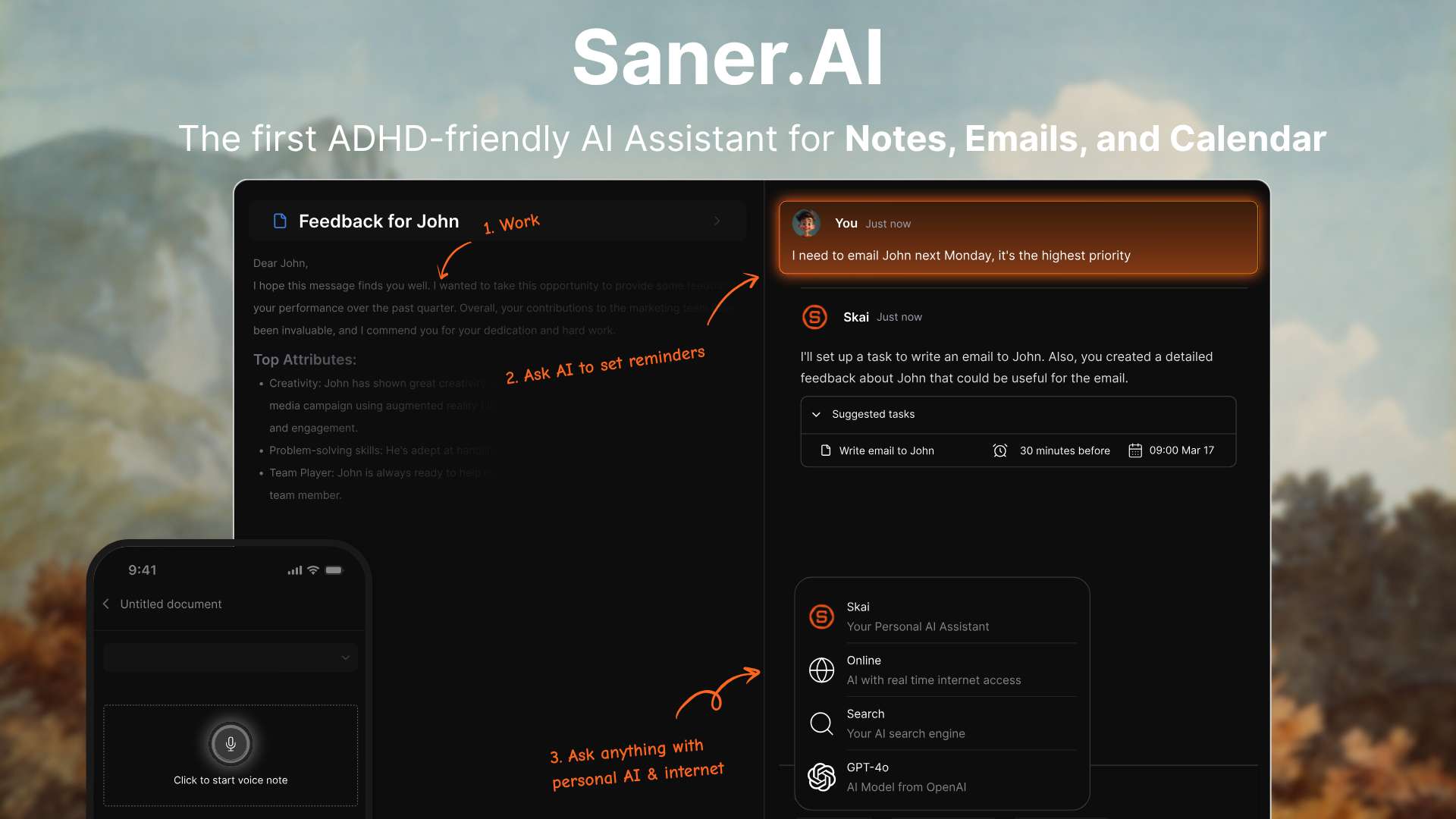
Saner.AI is an AI note-taking app designed to help you offload thoughts, turn them into organized knowledge, and get things done - all in one calm workspace. It’s built for people who think fast, get overwhelmed easily, or just want to stop losing ideas in a sea of tabs and docs.
What makes Saner stand out is its ability to understand your notes and let you ask questions like you're talking to a personal assistant. You don’t need to remember where something is - just ask, and it finds the answer.
Key features
- AI Search: Ask questions in natural language and get answers pulled directly from your notes
- Voice Notes: Add notes quickly with voice or message from your phone without opening the app
- Automatic Tags & Similar Notes: Helps you rediscover ideas you forgot you had
- All-in-One Workspace: Notes, to-dos, calendar tasks, reminders, and even Google results
- Daily Planning: Every morning, it suggests a prioritized day plan based on your tasks, emails, and calendar events.
- Task Assistant: Turns thoughts or messages into to-dos, reminders, or calendar events
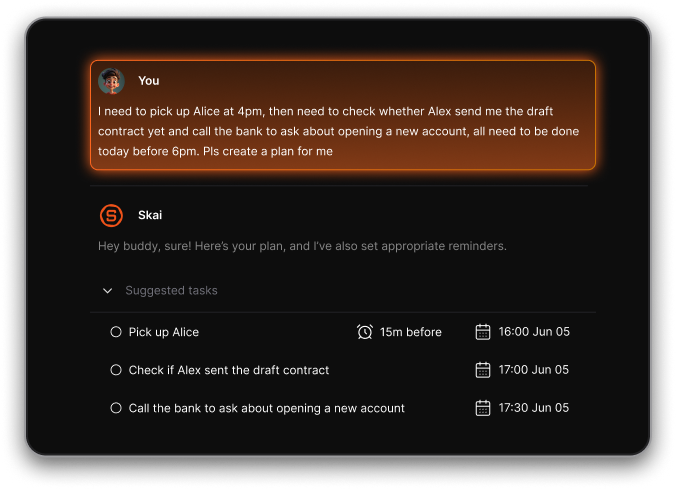
- Focus Mode: Clean writing and thinking space, distraction-free
- Chrome + Mobile Apps: Easy to clip from the web or capture on the go
What I liked
- What makes Saner.AI stand out is how it blends note-taking, task planning, and recall into one smooth experience. You don’t just write things down - you can actually talk to your notes.
- You don’t need to remember where anything is - just ask, and the AI pulls up what you’re looking for
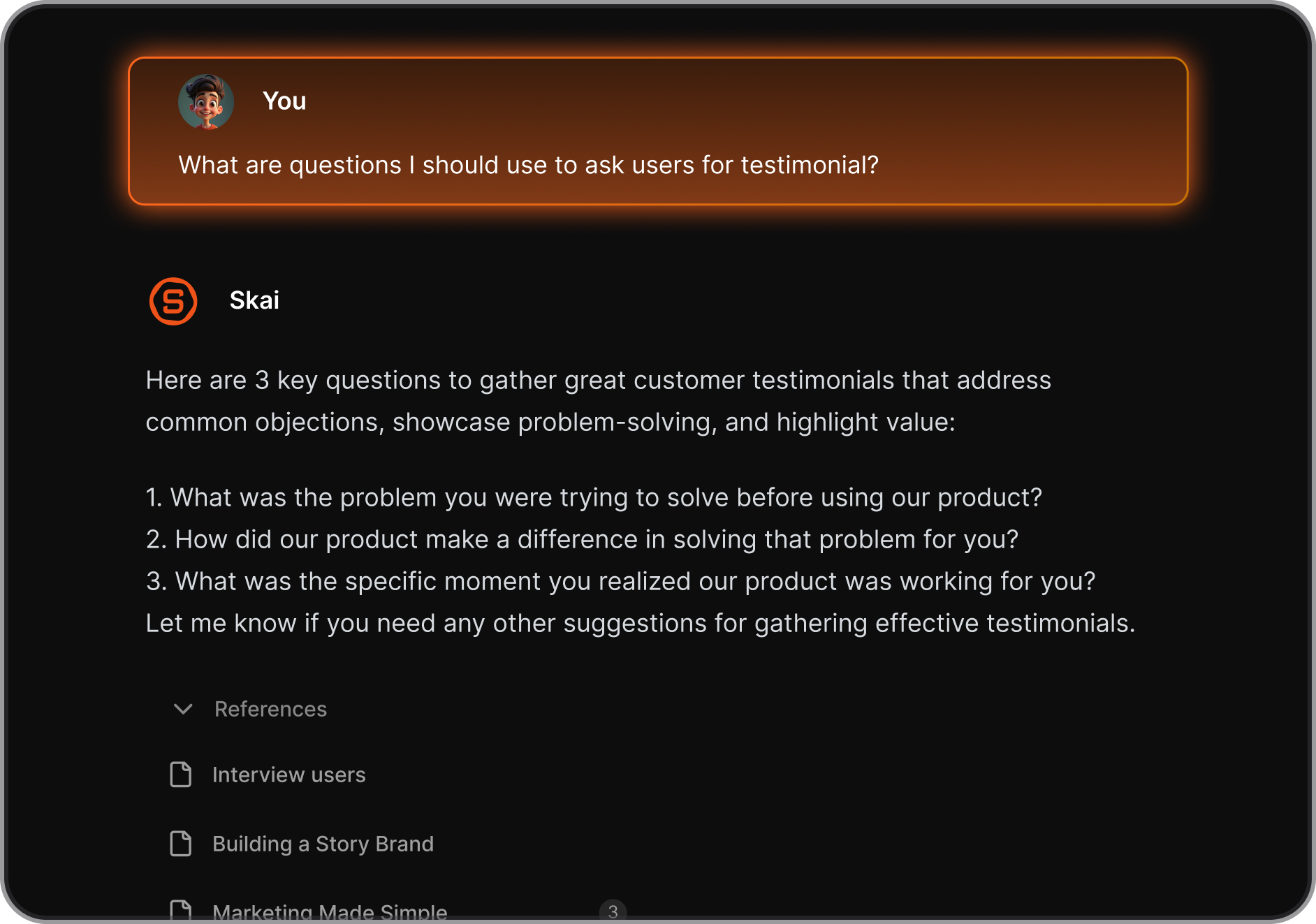
- It feels like a tool that helps you think clearly, not just store information.
Cons
- Requires internet access for full functionality.
Pricing
- Free
- Starter: Monthly at $8/month, Annually at $6/month (with early user discount)
- Standard: Monthly at $16/month, Annually at $12/month (with early user discount)
Suitable for
- People who want a note-taking app that’s always ready to capture, organize, and recall ideas - especially professionals, researchers, and ADHDers who struggle with traditional tools.
🔍 Quick Comparison With Other Note Apps
| Feature | Saner.AI | Typical Note Apps (e.g., Notion, Obsidian) |
|---|---|---|
| AI Assistant & Chat | ✅ Skai provides summaries & Q&A | ❌ Manual search only |
| Unified content source | ✅ Email, docs, Slack, tasks | ❌ Mostly siloed |
| ADHD‑friendly interface | ✅ Distraction‑free & minimal | ⚠️ May feel dense or choice‑heavy |
| Task extraction from text | ✅ Auto converts thoughts to tasks | ❌ Manual entry required |
| Version & export control | ⚠️ Limited export history | ✅ Full version history & open formats |
Saner.AI Reviews

How to start
- Head to saner.ai, create a free account, and start chatting with your AI assistant to organize your day, your notes, and your brain.
Stay on top of your work and life with an AI Note-taking app
2. Microsoft OneNote

OneNote is Microsoft’s digital notebook that helps you capture and organize ideas in a freeform way. You can type, draw, clip, or write anywhere on the page - just like a real notebook, but smarter. It works across devices and integrates tightly with Microsoft 365, making it a solid choice if you’re already in that ecosystem.
Key features
- Freeform Pages: Type, draw, paste, or clip anything—anywhere on the page
- Sections and Notebooks: Organize content with tabs and nested pages
- Handwriting Support: Write with a stylus and convert to text
- Sync Across Devices: Available on Windows, macOS, iOS, Android, and the web
- Real-Time Collaboration: Share notebooks and edit together
What I liked
- You’re not boxed into templates
- It integrates naturally with Microsoft tools like Outlook and Teams
- Completely free to use, even without a paid Microsoft 365 subscription
What I disliked
- The interface feels outdated, especially on mobile
- Search can be slow or inconsistent when notebooks get large
- Doesn’t have modern AI features like smart summaries or task management
Pricing
- Free with a Microsoft account
- Included with Microsoft 365 plans for business and education
Suitable for
Students, teachers, researchers, and professionals who want a flexible digital notebook and already use Microsoft tools.
How to start
Download the app or sign in with a Microsoft account to start your first notebook.
OneNote Review (source)

3. Apple Notes

Apple Notes is Apple’s built-in note-taking app available across iPhone, iPad, Mac, and now Apple Watch. It’s simple on the surface but surprisingly capable
Key features
- Liquid Glass redesign for a cleaner UI with swipe gestures and simplified toolbar
- Smart Script improves handwritten notes and lets you convert handwriting to text
- Markdown import/export for working across platforms and apps
- Call recording and transcription directly into your notes
What I liked
- Syncs instantly across all Apple devices using iCloud
- Supports multimedia notes
- Great for jotting ideas quickly without getting bogged down by too many features
What I disliked
- Doesn’t support backlinking, tags, or knowledge graph features
- Call transcription only works for recorded phone calls, not voice memos
- Some AI features require newer Apple devices (iPhone 15 Pro or later)
- No built-in calendar, task, or database views for advanced workflows
Pricing
- Completely free on all Apple devices.
Suitable for
- Great for individuals who live inside the Apple ecosystem and want a fast, clean way to capture and access notes anywhere
How to start
- Just open the Notes app on your Apple device.
Apple Notes reviews (source)

4. Notion
Notion is an all-in-one digital workspace that combines note-taking, task management, databases, and AI writing features. It’s designed for people who want to organize everything
Key features
- Block-based editor: Mix text, tables, calendars, kanban boards, and more on a single page
- Templates: Thousands of ready-made templates for tasks, journals, CRM, wikis, and more
- Integrations: Connects with tools like Slack, Jira, Zapier, Google Calendar, and GitHub
- Multi-language support: Now fully localized in Vietnamese, Thai, and other languages
What I liked:
- You can manage everything in one place without switching apps
- Notion AI helps you brainstorm or clean up writing right inside your notes
- The template ecosystem is massive, so you never have to start from scratch
What I disliked:
- It doesn’t work offline, so you need an internet connection to access or edit anything
- Large pages or complex databases can get slow, especially on mobile
- It takes time to learn - if you just want a simple notes app, it might feel overwhelming
- Search could be better, especially for older notes buried deep in a workspace
Pricing:
- Free plan available
- Plus plan at $10/month
- Business plan at $18/user/month
Suitable for:
- Knowledge workers, solo professionals, and teams looking for a flexible workspace to capture, organize, and build on their ideas
How to start:
- Go to Notion, sign up for a free account, and explore templates or start with a blank page.
Notion reviews (source)

5. Obsidian

Obsidian is a powerful Markdown-based note-taking app designed for deep thinkers and knowledge builders. It stores everything in local plain-text files, so your notes are always portable, secure, and future-proof. Instead of organizing in rigid folders, Obsidian lets you link ideas together and visualize your thoughts in a graph or canvas view.
Key features
- Markdown-based local note vaults
- Bi-directional linking between notes
- Graph View to visualize how ideas connect
- Canvas View for visual mapping and whiteboarding
- Plugin ecosystem with 1,200+ community-built add-ons
What I liked
- Notes are stored as plain text files, so you're never locked in
- Graph and Canvas views make it easy to spot patterns across topics
- You can customize everything through plugins
- Works well offline and respects your privacy by default
What I disliked
- Learning curve can be steep for beginners - best to start simple and layer on features
- No real-time collaboration or team-sharing tools built-in
- Requires you to install the app - no web-based version for quick access
Pricing
- Free for personal use
- Sync: $5/month
- Sync Plus: $10/month
- Commercial license: $50/user/year
Suitable for
Writers, researchers, and professionals who want a local-first, fully customizable note-taking system that doubles as a personal knowledge base.
How to start
Download the app from obsidian.md, create a new vault, and begin writing in Markdown. You can add plugins and themes as your workflow grows more advanced.
Obsidian review (source)

6. Joplin
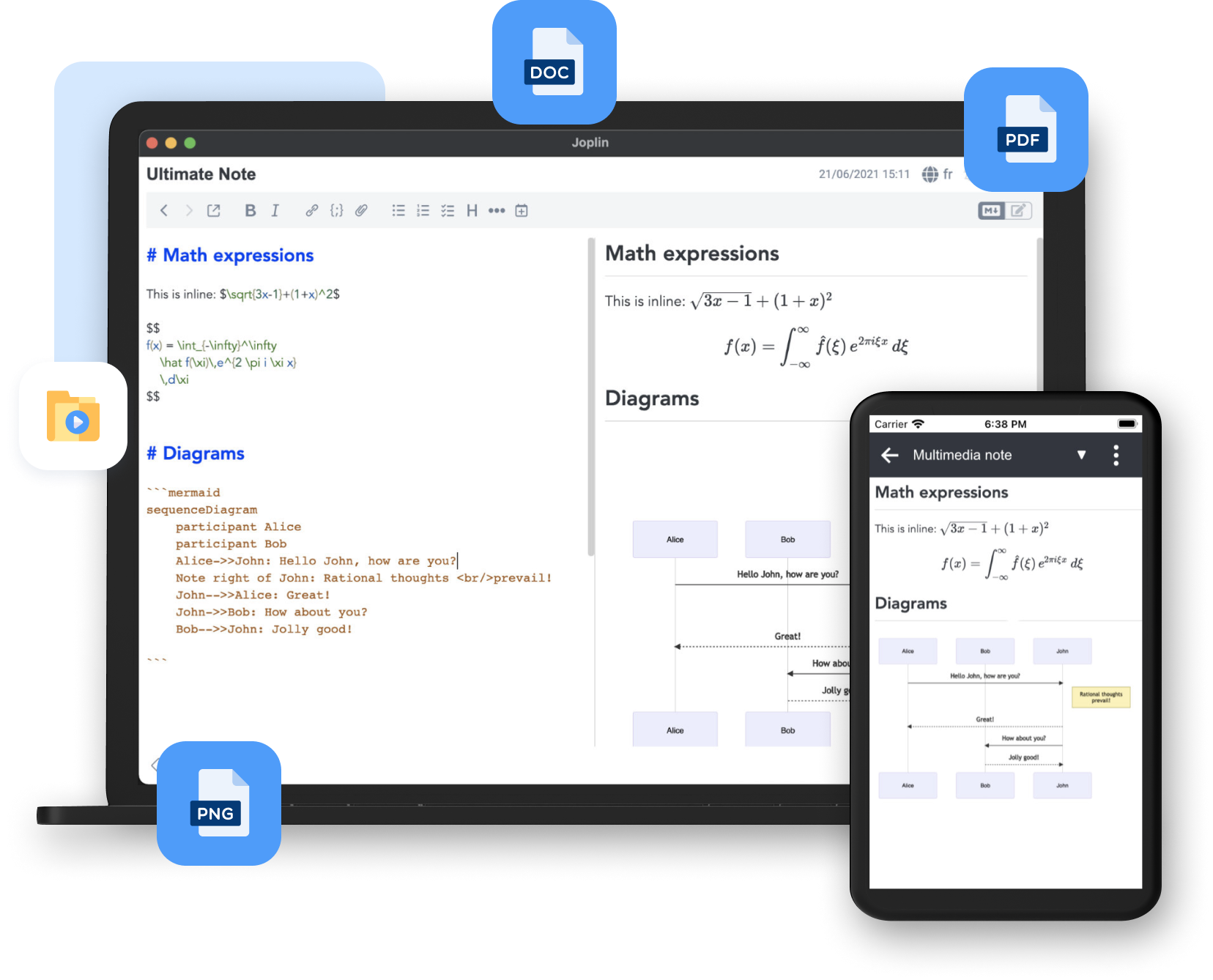
Joplin is a secure, open-source note-taking app built around Markdown. It works across devices and offers full offline access, end-to-end encryption, and rich customization through plugins. It’s designed for privacy-conscious users who want full control over their notes, without getting locked into a proprietary system.
Key features
- Markdown & rich text editing for clean, portable notes
- Notebook and tag organization to manage large knowledge bases
- Web clipper to save articles, screenshots, and full pages from the browser
- Built-in to-do lists and reminders for simple task management
- End-to-end encryption for secure syncing
What I liked
- Supports plain text Markdown while still offering a nice preview mode
- Plugin marketplace lets you shape the app to your workflow
- Fully functional offline and with strong encryption
- Not locked into a platform
What I disliked
- Interface is minimal and functional, but not as polished as tools like Notion or Bear
- OCR only works on mobile; desktop users need third-party tools or plugins
- Joplin Cloud requires a paid plan
Pricing
- Free plan: Local-only, no built-in sync
- Basic: €2.99/month — 2 GB storage, 10 MB per note
- Pro: €5.99/month — 30 GB storage, 200 MB per note
- Teams: €7.99/user/month — 50 GB storage and admin features
Suitable for
- Writers, developers, researchers, students, or privacy-first users who want full control over their notes without relying on Big Tech platforms.
How to start
- Download Joplin for free from their site or App Store.
Joplin reviews (source)

7. Bear
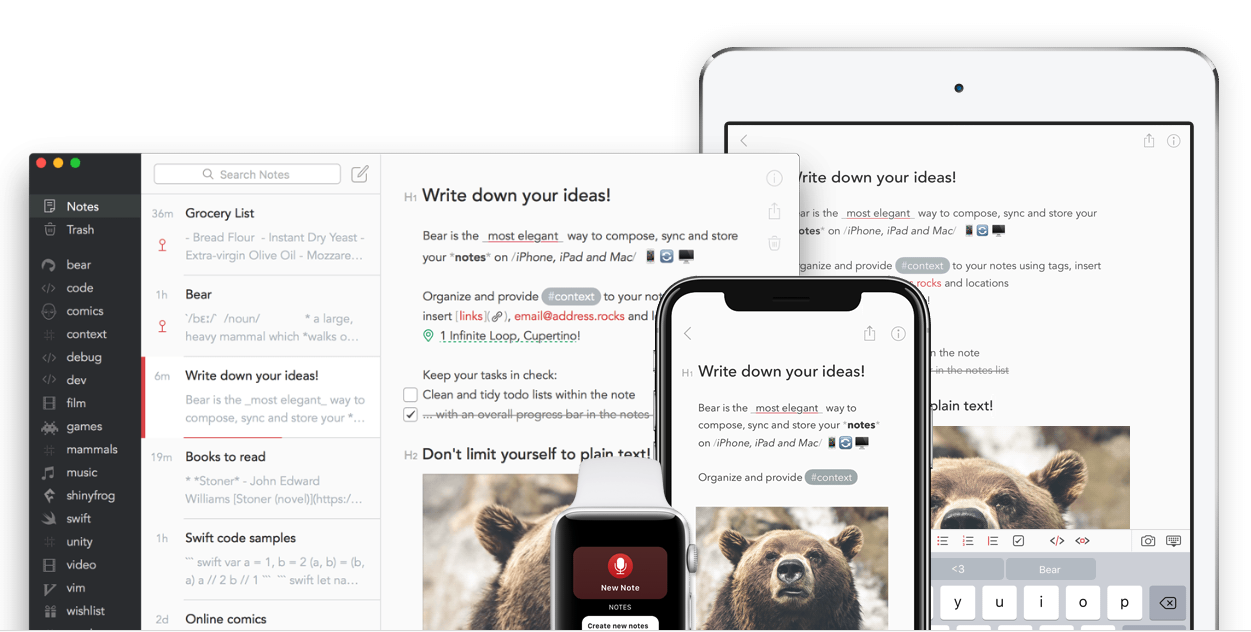
Bear is a beautifully designed Markdown-based note-taking app made for Apple users. It combines clean aesthetics with powerful features, perfect for writers, thinkers, and anyone who prefers minimal structure with flexible organization.
Key features
- Full Markdown support for rich, fast formatting
- Tag-based organization instead of folders
- Powerful search with support for backlinked notes and OCR in images/PDFs
- Encrypted notes, including media attachments (Pro only)
- Web beta version lets you access and edit notes from any browser
What I liked
- The UI feels fast and distraction-free, perfect for focused writing
- Tags work great
- Encryption for both text and files makes it privacy-friendly
What I disliked
- It’s still Apple-first - no native Windows or Android app
- The web beta is limited (no sketching or file exports yet)
- No real-time collaboration or team features
Pricing
- Free version available
- Bear Pro costs $1.49/month or $14.99/year
- Pro includes sync, encryption, web access, advanced export, and themes
Suitable for
- Writers, solo professionals, and Apple users who want a clean, Markdown-powered note app with great privacy features and flexible organization
How to start
- Download Bear from the App Store or sign up for the web beta.
Bear reviews (source)

8. Evernote
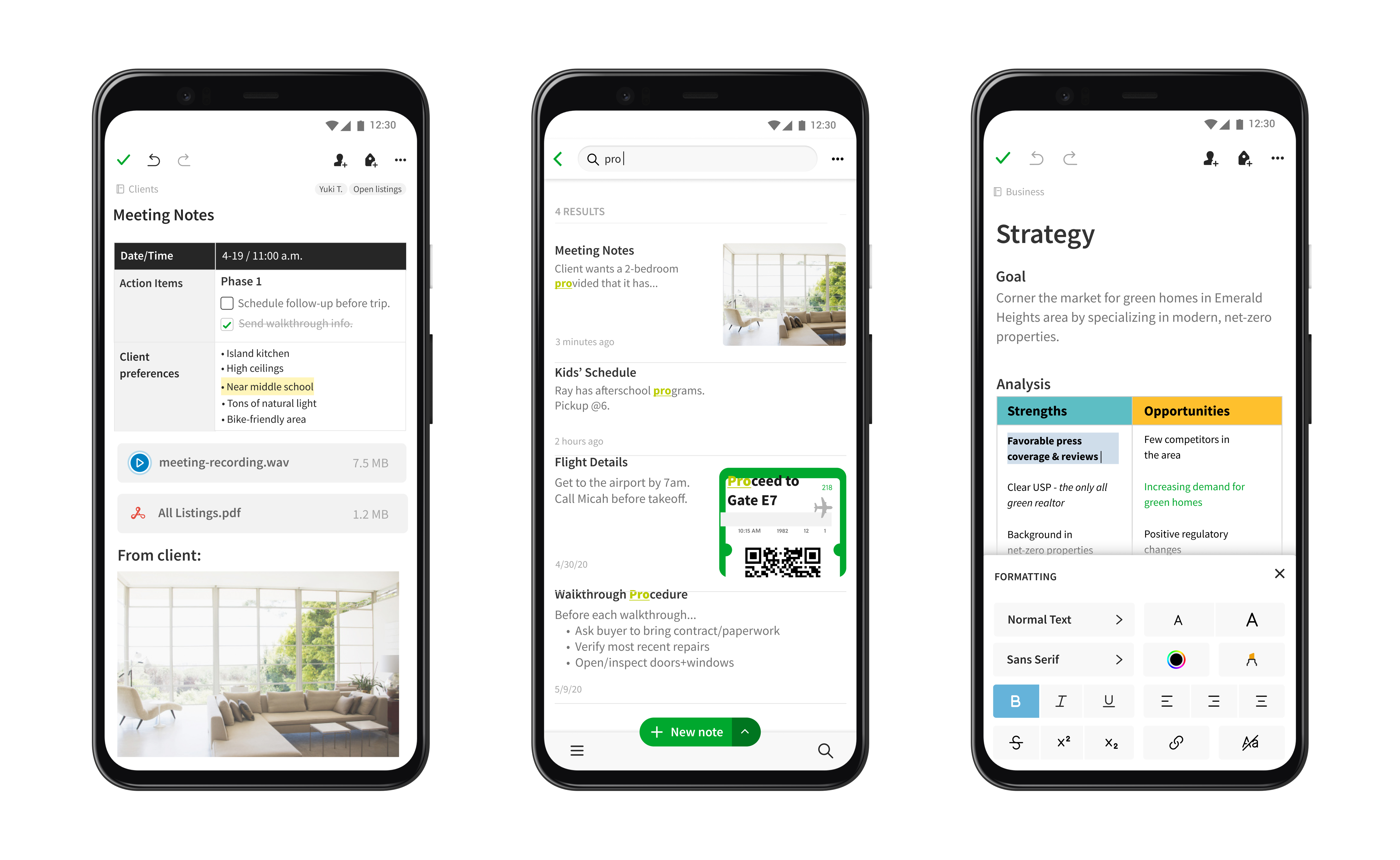
Evernote is a powerful note-taking app built for people who need serious organization and cross-device access. You can capture everything from text and PDFs to voice notes, web clippings, and photos
Key features
- Smart templates: Create custom note templates and reuse them easily
- Cross-device sync: Access and edit your notes from anywhere
- PDF & image search: Built-in OCR makes attachments searchable
- Web Clipper: Save full articles, screenshots, and web pages with a browser extension
- Tags & notebooks: Helps you keep everything organized and retrievable
What I liked
- The search is fast
- Handy template system saves time when starting repetitive notes
- Great for capturing mixed media: text, voice, images, scanned docs
What I disliked
- The free plan is extremely limited - only 50 notes, 1 notebook, and 250 MB/month
- Price hikes have frustrated long-time users, especially on renewals
- No true project planning features
- No AI Assistant where you can chat with
- Mobile app is fine, but not the smoothest for editing or organizing complex notes
Pricing
- Free: Limited to 50 notes, 1 notebook, 1 device, 250 MB/month
- Personal: $12.99/month or $129.99/year
- Professional: $17.99/month or $169.99/year
- Teams: $24.99/user/month or $249.99/user/year
Suitable for
Professionals, students, and anyone who needs a reliable note archive with powerful search and media support. Great if you work across multiple devices or need to save everything in one place.
How to start
Head to evernote.com, create a free account, and start testing it out. You can always upgrade once you hit the limits.
Evernote reviews (source)

9. Reflect
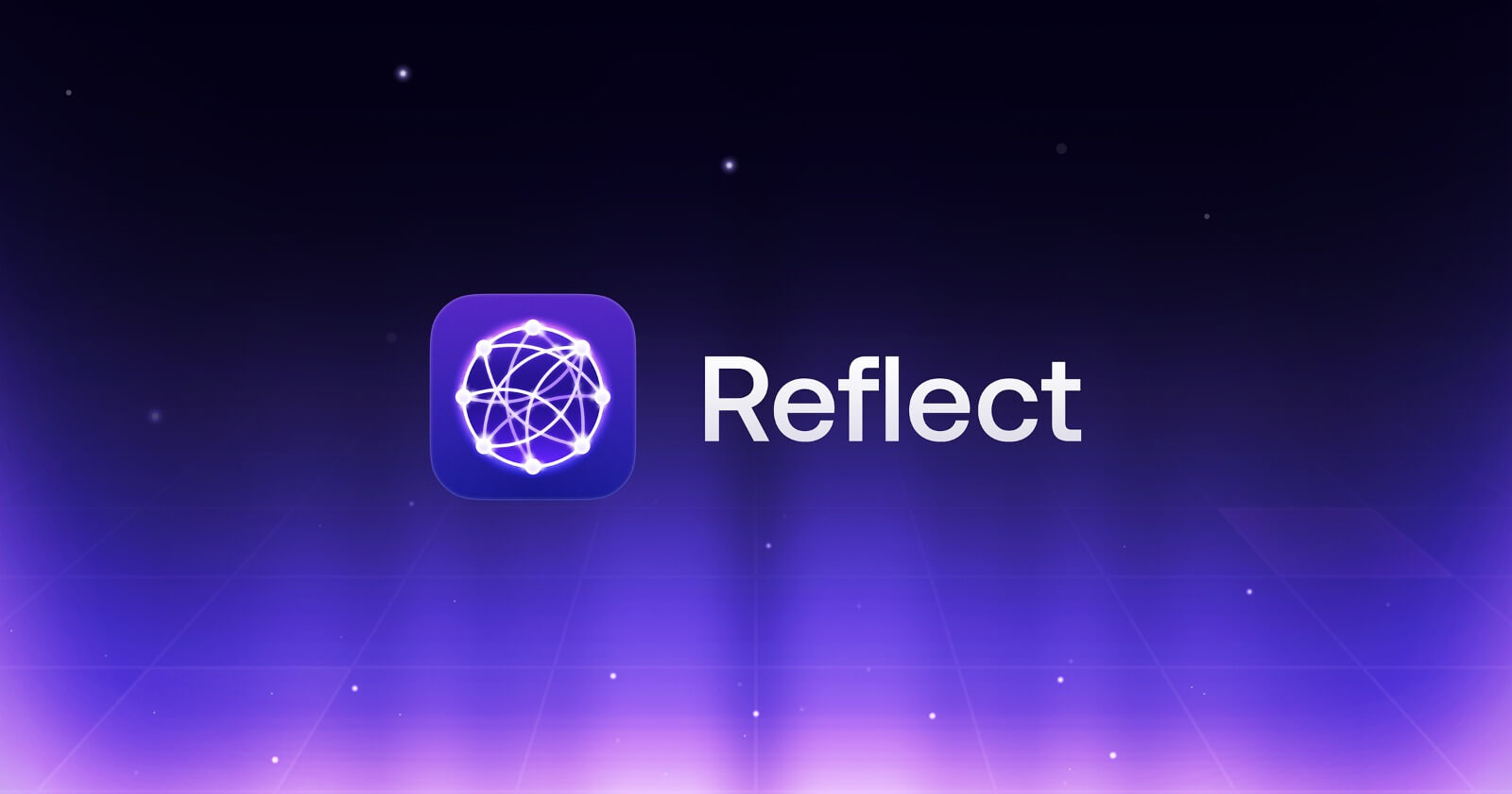
Reflect is a minimalistic note-taking app designed to help you capture thoughts quickly, link ideas seamlessly, and use built-in intelligence to extract insight. It’s built around speed, backlinks, and private sync
Key features
- AI Assistant: Chat with your notes using GPT-4 to summarize, rewrite, or extract insights
- Voice Notes & Transcription: Use Whisper to transcribe audio memos or meetings
- Backlinks & Graph View: Connect ideas and explore a visual map of your notes
- Web Clipper & Sync: Save ideas from anywhere and access across macOS, iOS, and web
What I liked
- Fast, frictionless note linking with autocomplete and suggested backlinks
- Clean design that encourages writing and thinking without clutter
- Sync is seamless across devices,
What I disliked
- No Android app yet
- No free tier beyond the 14-day trial, while others offer a basic free plan
- Not ideal for teams or project-heavy workflows - no kanban, timelines, or multi-user collaboration
Pricing
- 14-day free trial
- $10/month (billed annually) for full access
Suitable for
Writers, solo professionals, researchers, and anyone building a personal knowledge base who values clean design, fast capture, and thoughtful AI features.
How to start
Go to reflect.app, sign up for a free trial, and start writing and linking your ideas right away.
10. Mem
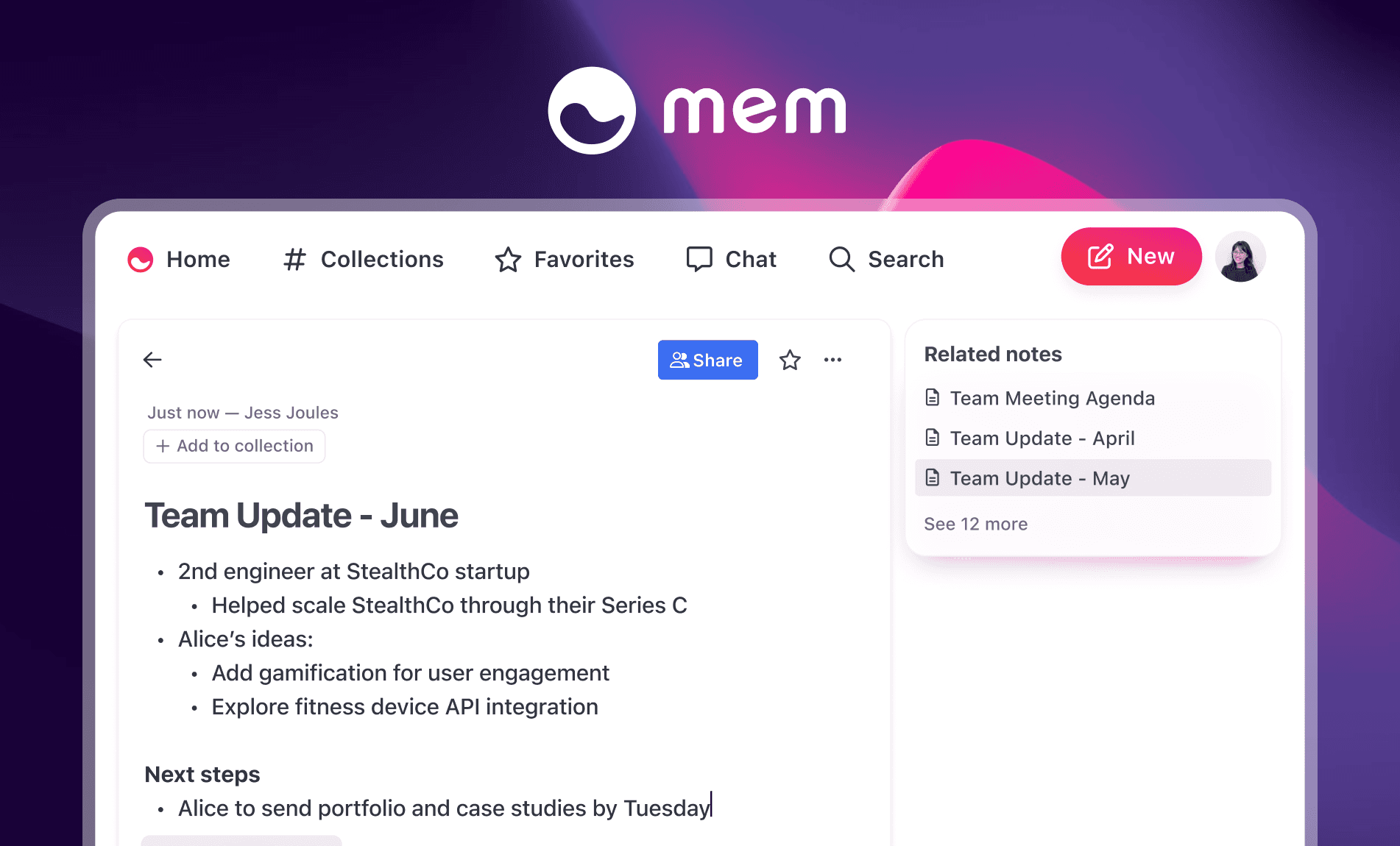
Mem is an AI note-taking app that acts like your second brain. It captures, organizes, and resurfaces information automatically.
Key features
- AI Copilot: Ask natural-language questions to retrieve or summarize relevant notes
- Smart Search: Instantly finds what you need, even from months ago
- Similar Mems: Dynamically surfaces related notes without manual tagging
- Cross-platform support: Web, Mac, Windows, and iOS with sync and offline mode
What I liked
- It can pull the right note with AI chat
- Smart Write helps you turn your thoughts into actual writing using your own notes
What I disliked
- Mobile experience — iOS app is still buggy, and there’s no Android version yet
- Unpredictable updates - features sometimes change or disappear with little notice
- Doesn't support emails, task management
Pricing
- Older versions had pricing around $8–10/month.
Suitable for
- Professionals, creatives, and teams who want an AI-first workspace that can recall, draft, and organize notes with minimal manual input.
How to start
- Go to mem.ai, sign up for a free account, and start capturing notes. The more you feed it, the more helpful it gets.
Mem Reviews (Source)
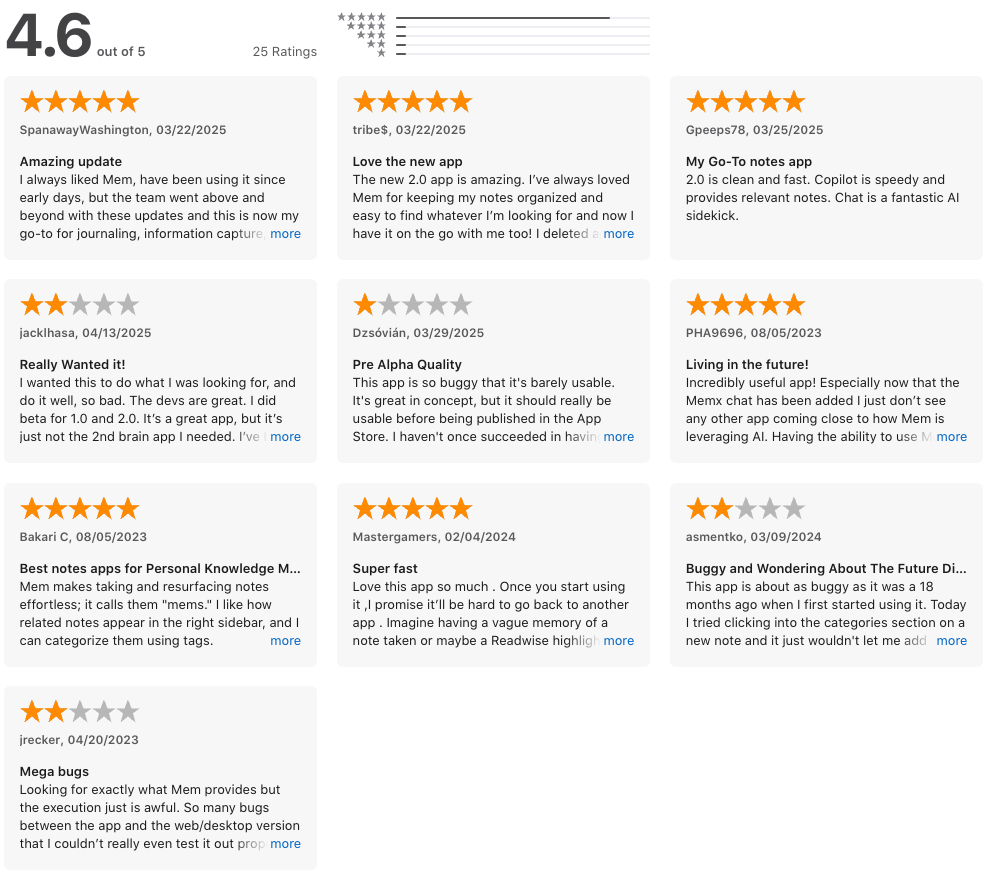
11. Goodnotes

Goodnotes 6 is a handwriting-first note-taking app that’s now expanding beyond iPad to Android, Windows, and web. It’s ideal for students, educators, and visual thinkers who want more flexibility than typing offers.
Key features
- Handwriting and typed text on the same page
- Annotate PDFs, images, and documents with Apple Pencil or stylus
- AI tools like handwriting spellcheck, tone adjuster, and math solver
- Math graphing: turn handwritten formulas into interactive plots
- Visual object menu: tap to resize, recolor, or edit any element
What I liked
- Fluid and precise handwriting that actually feels good to use
- Dynamic math graphing is surprisingly useful for STEM students
- Object editing is super smooth
What I disliked
- No continuous scroll or nested folders yet for long-form notes
- Some AI features are only available on iOS or in select regions
- The switch to a subscription model may feel pricey for casual users
Pricing
- Free plan: Create up to 3 notebooks with basic tools
- Subscription: $9.99/year for unlimited notebooks and AI features
- One-time purchase: $29.99 (Apple devices only)
Suitable for
Students, visual thinkers, and handwriting-first users who want an AI-enhanced note app that works across devices and helps them study, brainstorm, or organize without typing everything.
How to start
Download Goodnotes 6 on your device, create your first notebook
Goodnotes reviews (source)

12. Craft
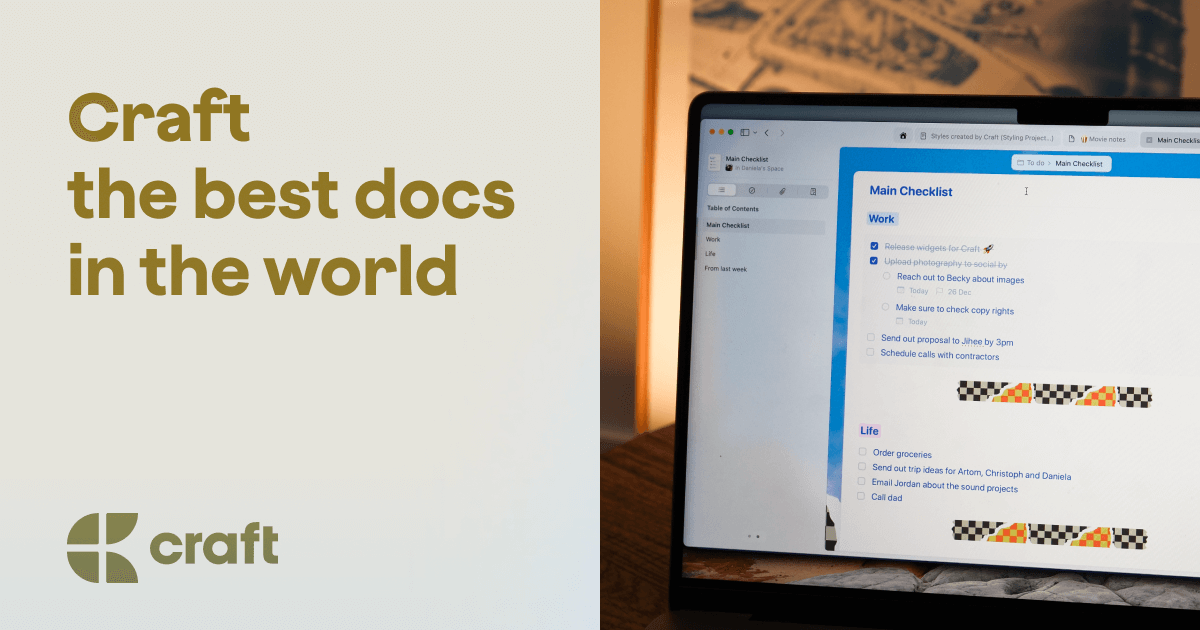
Craft is a beautifully designed note-taking app that blends writing, organization, and light task management into a clean, focused workspace. It’s built with Apple users in mind, but also works on Windows and web, with Android in development.
Key features
- Block-based editor that supports text, images, files, tables, and whiteboards
- Linked sub-pages and collections for wiki-style organization
- Built-in to-do list, daily notes, and calendar integration
- Offline-first: edit without internet, syncs when back online
What I liked
- The writing experience feels smooth and intentional
- Notes and tasks live in one place
- Organizing my ideas with subpages and backlinks feels natural
What I disliked
- Doesn’t support advanced task features like recurring tasks or subtasks
- Collections are more visual than functional - no complex database or filtering like Notion
- Android support is limited
- Better suited for individuals or small teams, not complex project workflows
Pricing
- Full version starts at around $10/month or $96/year
Suitable for
Writers, designers, and professionals who value aesthetics, simplicity, and flexible structure in a note-taking app
How to start
Go to craft.do, create a free account, and start writing your first note or daily entry. You can upgrade anytime if you outgrow the free tier.
Craft reviews (source)

13. Amplenote
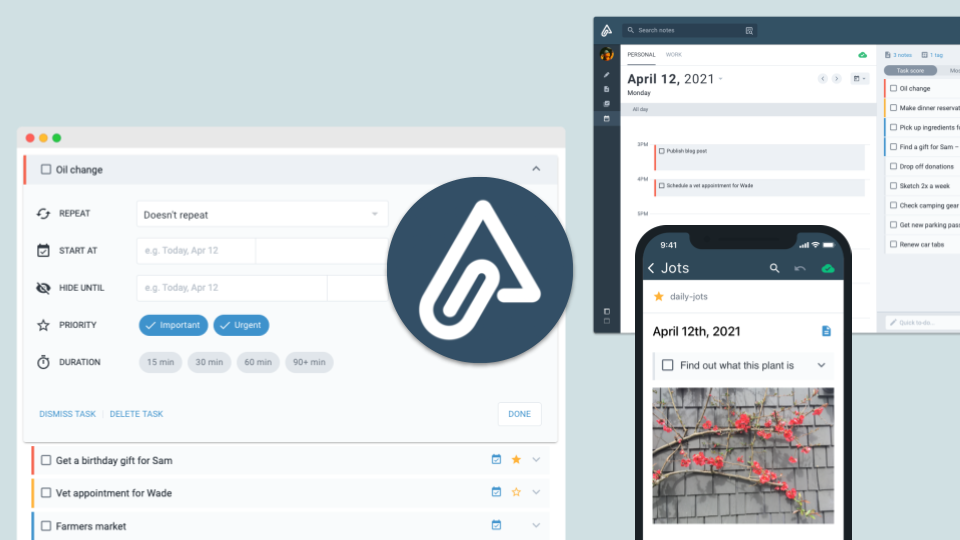
Amplenote is a powerful all-in-one note-taking app that blends notes, tasks, and calendar scheduling. It’s good for productivity enthusiasts who want a focused, secure space to think, plan, and execute
Key features
- Rich Footnotes: Add inline context like images, links, and sub-notes without breaking flow
- Tasks + Notes: Combine todos with your notes and schedule them seamlessly
- Calendar Integration: Drag tasks into your Google or Outlook calendar
- Vault Notes: Keep sensitive notes locked and encrypted
- Cross-Platform Support: Available on mobile, web, and native desktop (in beta)
What I liked
- Tasks, notes, and calendar feel connected
- Task scoring helps reduce mental fatigue by surfacing what matters most
- Strong mobile experience with reliable offline access
What I disliked
- The interface feels a bit dated compared to newer tools like Saner.AI or Craft
- Workflow can be overwhelming at first - takes time to learn the full system
- The desktop app is still in beta and lacks some polish
- UI has a lot of features packed in, which may feel cluttered to minimalist users
- Don't have an AI Assistant to talk to
Pricing
- Free Personal plan available
- Pro plan at $5.84/month
- Unlimited plan at $10/month
- Founder plan at $20/month
Suitable for
Productivity-focused individuals, PKM enthusiasts, and anyone who wants to combine ideas, tasks, and planning in one secure place
How to start
Head to amplenote.com, create a free account, and try the daily Jots + task workflow to see if it fits your brain.
Amplenote reviews (source)

14. Tana
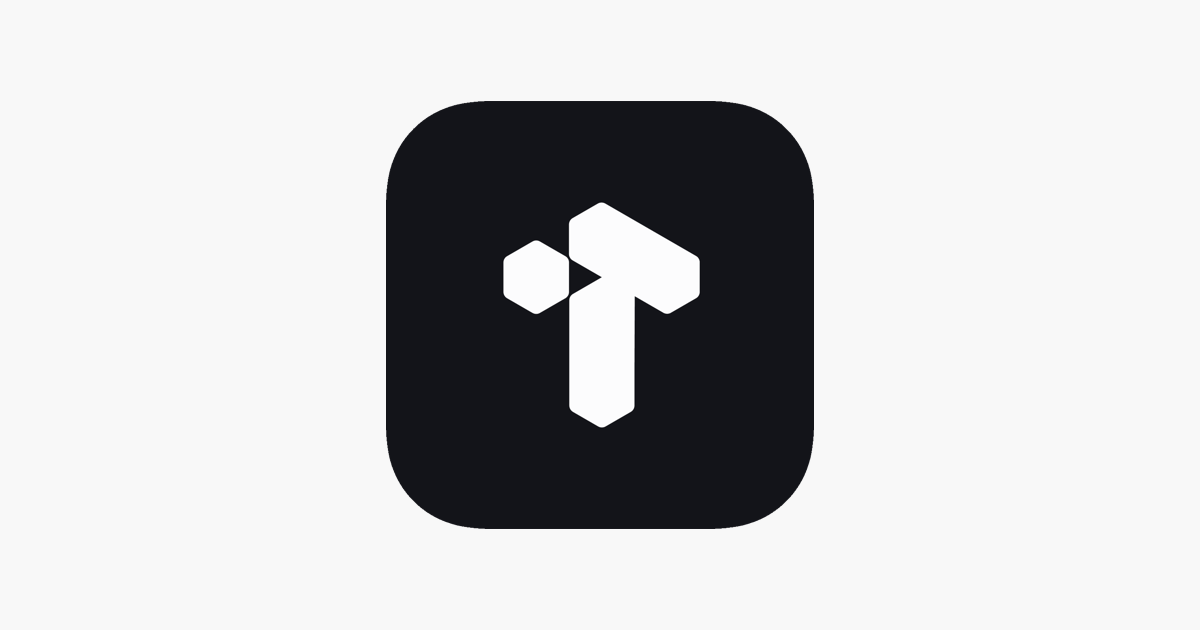
Tana is a graph-powered note-taking app that turns every thought into a linkable, structured node. Built for deep thinkers and knowledge workers, it blends outlining, tagging, and automation into one fluid workspace
Key features
- Node-based structure: Every line is a “node” that can be nested, linked, or tagged - like combining a bullet outliner and a knowledge graph
- Supertags: Custom templates that turn tags into smart databases with properties like due dates, priorities, or statuses
- Daily page: A central place to start your day, organize tasks, take notes, and reflect
- Mobile + desktop support: Full-featured apps on iOS, Android, and web — with offline capture and editing
What I liked
- The node-based model makes everything feel connected
- Supertags are powerful - You can build lightweight task managers or reading trackers without extra tools
What I disliked
- The learning curve is real - getting used to nodes, tags, and filtered views takes time
- Exporting your data isn’t seamless yet, which might worry people who want full control
- It’s not designed for project management
- Some advanced features are still in early stages or limited to power users
Pricing
- Free plan includes core features like nodes, tags, and daily pages
- Paid plans unlock AI workflows and advanced automation (pricing varies, still evolving)
Suitable for
- Knowledge workers, creators, researchers, and productivity nerds who want a customizable, all-in-one system for thinking, planning, and growing ideas
How to start
- Go to tana.inc and create an account.
Tana Reviews (Source)

15. Logseq

Logseq is an open-source, privacy-first note-taking app that helps you build a personal knowledge base with structure and flexibility. It uses a block-based outliner system with bi-directional links, turning your notes into a powerful knowledge graph
Key features
- Block-based Outliner: Each bullet is a movable block that can be linked, tagged, or nested for maximum flexibility
- Bi-directional Links: Connect notes in both directions to build a networked knowledge base
- Markdown & Org-mode Support: Compatible with plain-text formats that can be opened anywhere
- Plugins & Custom Themes: Extend functionality with community-built add-ons
What I liked
- Notes are organized into flexible blocks that make it easy to restructure ideas as you think
- You can link everything
- The focus on privacy and local-first storage means your data stays yours
- There’s a growing plugin ecosystem for things like Kanban, Zotero, and queries
What I disliked
- The learning curve is real — especially if you’re not familiar with outliners or knowledge graphs
- It slows down with large note collections if not carefully maintained
- Mobile experience is improving, but still lags behind the desktop version
- No AI Assistant
Pricing
- Free and open-source
- Optional paid Logseq Sync (currently in beta)
Suitable for
- Students, researchers, writers, and knowledge workers
How to start
- Download Logseq from logseq.com, install it on your device, and create your first graph.
Logseq review (source)

🧠 Conclusion: The Best Note-Taking App Is the One That Thinks Like You
In 2025, note-taking is no longer just about jotting things down - it’s about building a thinking system that supports your brain.
Whether you’re capturing ideas during a chaotic meeting, outlining your next research paper, or just trying to keep your week organized, the right tool can make the difference between mental clutter and clarity.
From Saner.AI, which proactively helps you organize, prioritize, and follow through - especially if you have ADHD or juggle multiple responsibilities - to Notion, the all-in-one powerhouse for teams, and Obsidian, beloved by deep thinkers and Second Brain nerds, every app on this list serves a unique type of mind.
If you’re still switching between sticky notes, random docs, and voice memos, now might be the perfect time to upgrade.
✨ The bottom line? The best note-taking app isn't the one with the most features - it's the one that fits your thinking style, reduces friction, and helps you act on your ideas.
FAQ: Best Note-Taking Apps
1. What is a note-taking app?
A note-taking app helps you capture, organize, and revisit your ideas - digitally. Whether it’s meeting notes, personal reflections, or research highlights, these tools make it easy to store and find information when you need it.
The best note-taking apps today go beyond just “typing notes.” They offer:
- AI-powered search
- Smart organization (tags, backlinks, folders)
- Task and calendar integration
- Voice input or handwriting support
- Cross-platform syncing (phone, tablet, desktop)
Popular options include:
Saner.AI, Notion, Obsidian, Apple Notes, Evernote, Reflect, Tana, Logseq, Mem, OneNote, Joplin, AmpleNote, Bear, Craft, GoodNotes
2. What’s the best note-taking app overall?
It depends on how your brain works and what you need to remember.
- Saner.AI – Best for AI organization, task reminders, and ADHD-friendly focus
- Notion – Best for collaborative docs and flexible databases
- Obsidian – Best for second-brain thinkers who love local files and backlinks
- Apple Notes – Best for simplicity and seamless Apple ecosystem
- Reflect / Logseq / Tana – Best for daily journaling and networked thinking
- Mem / Bear / Craft – Best for fast capture
- GoodNotes – Best for handwritten notes and planners
No single app wins for everyone. Many people use a combo based on their workflow.
3. What’s the best free note-taking app?
Several top tools offer generous free plans:
- Saner.AI – Free forever plan with AI chat, smart search, and task reminders
- Obsidian – Free for personal use with powerful markdown and local storage
- Apple Notes – Free and pre-installed on all Apple devices
- Logseq – Open-source and completely free
- Joplin – Free, open-source, with end-to-end encryption
- Notion – Free for individuals with generous feature limits
4. Which note-taking app is best for work or productivity?
- Saner.AI is designed to reduce context switching. Just chat to find notes, summarize emails, or schedule tasks. Ideal for busy professionals juggling meetings, deadlines, and ideas.

- Notion shines in team settings and project planning.
- Obsidian and Logseq are perfect for deep work, research, and building a second brain.
- OneNote is great for corporate environments and educational notes.
5. What’s the best note-taking app for students?
- GoodNotes – Handwriting support + organization = perfect for lectures
- OneNote – Flexible structure and works well with stylus
- Notion – Great for combining reading lists, class notes, and tasks
- Saner.AI – Helps overwhelmed students by turning messy ideas into organized tasks with reminders
6. Which note-taking app is best for ADHD?
Saner.AI is built with ADHD in mind. It helps reduce overwhelm by:
- Turning your thoughts into clear action steps
- Reminding you at the right time
- Connecting notes, tasks, and calendar in one clean space
- Letting you chat instead of clicking through tabs
No tags. No friction. Just clarity.
7. Which note-taking app has the best AI features?
Top AI note-taking tools in 2025 include:
- Saner.AI – Understands your notes, chats like an assistant, and reminds you of what matters
- Mem – Auto-organizes notes with minimal manual effort
- Reflect – AI features like summarization and backlinks for personal knowledge management
- Notion – AI assistant helps with summaries, writing, and translating
8. Can note-taking apps help with task and calendar management too?
Some can. A few even do it really well:
- Saner.AI – Tasks, calendar, and notes are connected. It can pull up a task from your notes and suggest the best time to do it.
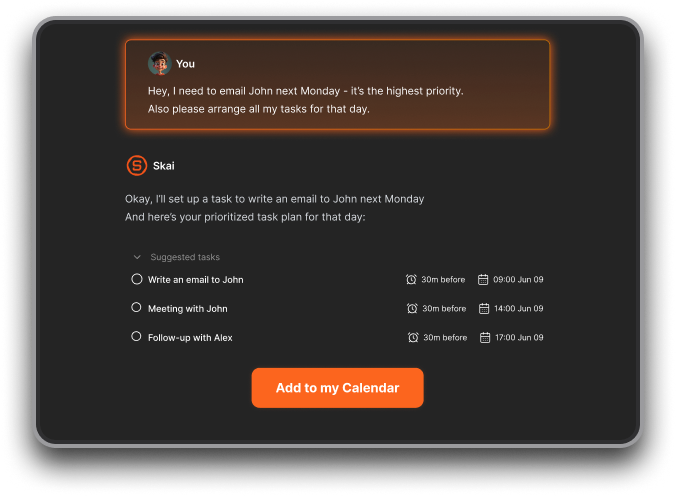
- AmpleNote – Combines note-taking with task priority scoring.
- Notion – Custom databases make it possible, but you’ll need setup time.
9. What’s the best note-taking app for creative writing and journaling?
- Bear – Beautiful interface and markdown support
- Reflect – Designed for daily writing and personal thinking
- Craft – Gorgeous design and good for writers
- Saner.AI – Helpful when you want to turn spontaneous ideas into follow-up tasks or structured projects
10. How do I choose the right note-taking app for me?
Ask yourself:
- Do I just need a place to jot things down? → Apple Notes
- Do I need a thinking tool or second brain? → Obsidian, Saner.AI, Tana
- Do I want AI to organize for me? → Saner.AI, Mem, Reflect
- Do I work in teams? → Notion, OneNote
- Do I take handwritten notes? → GoodNotes, OneNote
- Do I forget to review notes? → Saner.AI – it reminds you when it’s time
Start with what feels intuitive. The best tool is the one you’ll actually use.
Stay on top of your work and life

